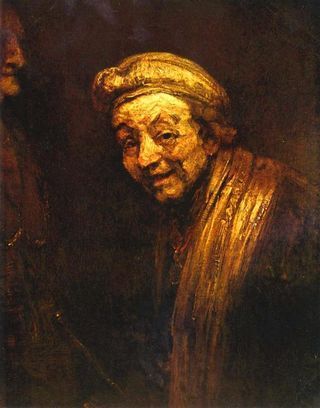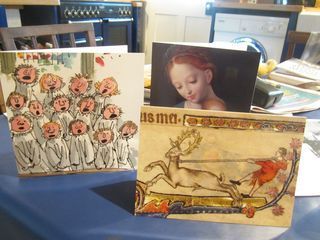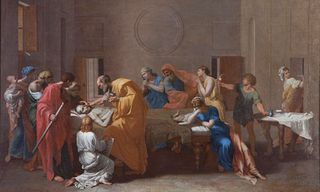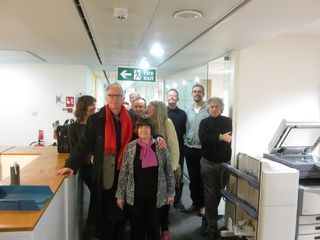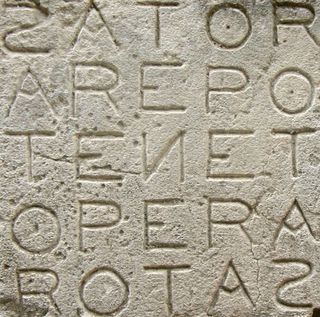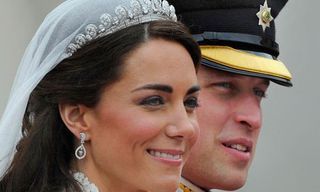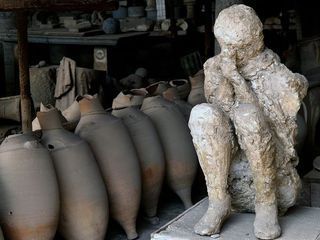Mary Beard's Blog, page 49
December 25, 2012
Happy Christmas
I always like to do a post on Christmas Day, which I am not sure is entirely to my credit. I mean it's nice to extend Christmas wishes etc, but I suspect that I am also trying to prove to you that I am still awake and blogging (your faithful blogging don never stops, as it were). Not to mention the little brag about my trees, which I'm rather proud of glimpse above -- you can just spot Santa in a yellow New York taxi, acquired by the son last year, first prize for splendid bauble bad taste, closely followed by Santa in a stars and stripes hat).
Anyway this year we have both kids back from being away, and -- also a pleasure to say -- we have Samuel from South Sudan staying with us, and Weimo a Newnham student from China coming for Christmas dinner. And, yes, I've really got into the spirit of it: wreath on the door, mistletoe over the stairs, holly on the pudding, chestnuts on the fire (there's not a tradition that goes uninvented down our way).
That said, it can be a bit hard to decide whether the whole present routine (which, yes, I love...esp.with a glass of champagne plus smoked salmon under the glittering tree) is the final context for the expression of family affection, or the last gasp of late capitalism. Quite how much money is spent by the few on the few each December is a nasty question (notwithstanding all our virtuous donations to good causes).
This year has been more stressful than most in the present department. I made a dash to London and bought a couple of nice things at Liberty's... I then wished I had just done the lot there rather than trogging round Covent Garden (not to mention Heal's, a poor shadow of its former self) and done worse. The son (who was on the hunt for a stuffed robin ..and yes he knows the environmental/ethical issues -- to give to the eponymous father) ended up driving to the other side of Nottingham to pick one up (yes, late capitalism has its moments of singleminded effort associated with it). The truth was that the bird in Notts was less than half the price of a decidedly nastier specimen available in Islington.
The truth is though that -- however all this gets analysed in 500 years time, late capitalism or not -- it nevertheless contrives to retain its fun, and to do the bonding job it is supposed to do.
And I am just going to pick out the Kind Hearts and Coronets dvd to watch with Samuel and Weimo as a classic glimpe of British culture (that's after by rather feeble attempt yesterday to explain to Samuel the particular mode of transport adopted by Father Christmas) .. before I get down to the giblet gravy and brandy butter.
HAPPY CHRISTMAS anyone reading this.
December 23, 2012
Time wins the race (and dying of laughter)
I have been having a little race against time this week. That is to say the idea was that by Christmas day I would have finished the penultimate chapter of my laughter book -- which would leave one chapter to be written by 12th Night (the final target, and not so unrealistic as it might seem, as I have quite a polished lecture-version of what I want to say).
So every day I have been lighting the fire in the sitting room and sitting in a big armchair wired up to my laptop, books around my feet, typing away (something you couldnt have done before the age of JSTOR, I reflect -- almost every journal article I want, I can just call up onto my screen). It has been quite fun actually, but the fact is that I'm not going to make it by Christmas Day. Time is going to win by about 1000 words. (OK I could just keep slogging at it right up to midnight on Xmas morning, but there the presents to wrap and the cake to ice and the bird to stuff....)
The problem has been not a "block". In fact, I've been getting down well over 1000 words a day, and words that I'm fairly happy with. It's rather that I've found I had more to say than I thought (what I thought I could skip over in a brisk 750 words turned into a chunky 2500 word section). In particular over the last few days, I've been getting stuck into the ancient and modern trope of people who died laughing (you find it all over Western history, I'm not so sure about non-Western to be honest).
There are all kinds of examples...like Anthony Trollope who was supposed to have corpsed in the middle of a family reading of F. A. Anstey's comic novel Vice Versa (though it's a bit hard now to see what was quite so funny in it), or the unfortunate Mrs Fitzherbert who in 1782 collapsed in hysterics at a performance of the Beggars Opera and died a couple of day later, or more recently in 1975 the guy from Kings Lynn who died of laughter in the middle of an episode of the TV comedy, The Goodies.
In the ancient world there are similar stories, often told by Roman writers of earlier Greek celebrites. Festus tells, for example, of the death by laughter of the painter Zeuxis. And much the same is said of the philosopher Chrysippus, and the comic poet Philemon.
There is an awful lot of stuff written about whether, or in what sense, any of these deaths could possibly be true. Did the laughter trigger a heart attack? Or was the laughter itself the side effect of some underlying neurological condition/tumour? But that's not what I'm on about in my chapter.
I'm interested in what the ancient prompts were to these fatal hysterics. What was so funny to cause this corpsing? And how would be understand that?
In the case of Zeuxis, it was said to be looking at painting he had done of an old woman (that is probably what Rembrandt is alluding to in the self-portrait at the top of this post, the figure of the old lady is on the left of the canvas)... a classic example of ancient misogyny? or, as I would want to argue, a hint at the close connection between ancient laughter and imitation/mimesis.
For Chrysippus and Philemon it was seeing a donkey who had drunk wine eating figs that were meant for their own supper. Why so funny? My argument here is that it is something to do with crossing species boundaries. The donkey is acting like a human being.... And you can guess where the chapter is going to end up (on December 28th): with a quick romp through the Golden Ass, the hilarities of Lucius' transformation into an animal, and the festival of the God Laughter that the novel puts centre stage.
Now off to light the fire and sit down and write.
December 19, 2012
How useless are cctv cameras?
One of the things our South Sudanese friend has found very puzzling about the UK is all the notices about cctv cameras, and how you are being surveyed for your own safety, etc etc .
Quite reasonably too. Just imagine how mad/sinister our own surveillance culture would look from anywhere else on the planet.
That said, the one good thing about the whole camera culture is that it is, by and large, so inefficient. I remember years ago that there was a nice full page spread in the Cambridge News with camera mug shots of local villains, who were either clear as day, but unrecognisable on any list of criminals -- or blurry and equally unrecognisable (whether on a list or not).
And you couldn't want a clearer indication of how useless cctv cameras are than the sequel to Plebgate.
Here I have to acknowledge the husband's line. Whatever the truth, he has never thought that the basic police/press account of the Andrew Mitchell story quiteadded up. Where were these witnesses to the notorious slurs, he asked?
Well never mind the other evidence, now we know that the cctv cameras in Downing St are too low resolution to identify anyone, and there is no sound recording. The most terrorist sensitive place in the country and the systems are useless?
The truth is that we libertarians are rather relieved at this hopelessness (thank god the cameras are so dead useless, else civil liberties would really be under threat). But do we really mean to say that some moneymaking company has put cameras in Downing Street that can't identify a potential villain? At what cost? And where was all this evidence of plebgate for the last two months?
I dont hold any brief for A Mitchell (far from it), but I do begin to wonder what we think we know he said, and whether it could possibly be true.
December 16, 2012
E-Christmas card? No thanks
I have a soft spot for Christmas cards . . . both sending and receiving. As for sending, I rather take pleasure in choosing the right card for the right person (all mine are from the Fitzwilliam Museum this year -- as you can see above) -- the nice Madonna for those I know or suspect are religious types, the Quentin Blake of the choristers, for those who would like a bit of a Cambridge feel, etc .
Quite who is on my "Christmas card list" is a question that would keep an anthropological analyst of gift-exchange going for an hour or so. I exchange cards with some people I see often (and yet there are others of my day to day mates that I would never dream of sending a card to . . . I guess in part we have mutually decided, probably years ago, whether we would have a "card" relationship or not). But there are, of course, also a large number of people with whom the only contact I now have is the Christmas card. It's what lets us still claim we know each other -- giving the card up, and that would be that.
I'm not just talking about the more or less distant relatives. In my case it's the girl from my village I used to play with 50 years ago. Why not let her go? you ask. The simple answer is that I dont want to, and the fact that we think about each other once a year, as we put our cards in the envelope, is well worth the couple of quid it must now cost. (As I was writing this, I just heard someone on the radio saying how useless it was to write "Hope we catch up in 2013", like one has written ever since 2001, and never got round to it. Well true, but better than not writing it all, I say.)
But the other side is the receiving of them, opening them up, remembering the sender for a little while -- then displaying them around the house. I pick out my very favourites and put them on the mantelpiece, and squeeze the others wherever they'll fit, balancing the ones left (with the help of a bit of blutack) on the picture rail.
It's classic ritualised activity -- as utterly meaningful as it is totally pointless.
But that's where the gripe at the top of this post comes in. I'm sorry if this offends all my friends and acquaintances who have just constructed and "sent" their e-cards. But what on earth is the point. However "all singing and dancing" they are, the idea of dispatching it at one click to the whole of your address book just isn't the same as writing "Love Mary and Robin, hope we see you in 2013" and licking the envelope and sticking the stamp on.. all individually. Besides, the smarter these e-cards are, the more they clog up your inbox... and you cant put them on the mantelpiece. So what is the use.
(That said, I did have one great electronic greetings yesterday, from a uni friend who -- in desperation with the card routine -- sent a handful of electonic pics, including a couple of him as a tiny boy. I spent a good few minutes trying to detect the grown up Alastair in these 1960s image, and giggling to myself. That WAS pleasure.)
December 12, 2012
Carols at King's

I have lived in Cambridge for more or less 40 years now, and had never been to a Christmas carol service at King's -- until last weekend, when we went (thanks to a generous and lucky invitation) to the recording of the tv version of the service. I had always been puzzled in fact about the relationship of that tv version, recorded mid December and broadcast sometime over Christmas, to the live "9 lessons" version broadcast live on Christmas Eve afternoon -- and now I know the answer.
They both start off with "Once in Royal David's City", and there is a bit of overlap in other bits of music and lessons. But in fact after the opening, they do each go their different ways. The tv one we went to has only 7 lessons, and some of those are "secular", like a bit of Laurie Lee this year. (See how quickly the erstwhile ignorant become expert!)
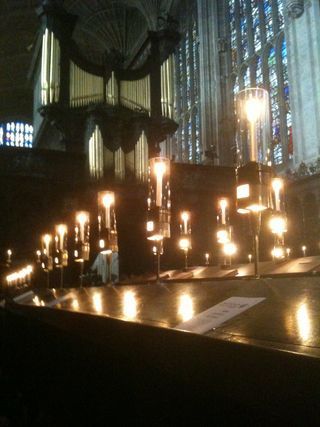
Anyway, the truth is that it was overwhelming. We had seats at the back of the choir (that's where I've taken the picture from). So it was a kind of ringside seat. But that wasnt the best thing.
The fact is that some of these big occasions are really better on the tv or radio (I've never especially wanted to go to Wimbledon -- except for the curiosity of "what's it like" -- when you can see every bit of it perfectly with a Pimm's in your own living room). But others are even better when you're there than you could ever have imagined.
These carols came into the latter category. And, I can tell you, I really was shedding a little tear at that gorgeous boy's solo in Once in Royal David's City. In an odd way, the real live acoustics of the place make it all the more plangent. I remember that ten years or so ago I gave a reading at a memorial service in the chapel, and echo made it hellish difficult to do. You had to speak really slow else your next words got caught up in the echo of the last ones, if you see what I mean.
But that echo with the boy's voice worked wondrously. Gob smacking, even for this old cynic.
On a more usual and hard-headed note, it was great to have a real meaty order of service, with all the carols printed out in full. It did make you reflect on what made a good carol, what was the right blend of sentimentality and jolliness, and why some people seem to have had a knack (Christina Rosetti, for example -- with In the Bleak Midwinter AND Love came down at Christmas). It also made you reflect on how weird some of the words were (what actually does "no crib for a bed" mean?).
But, all in all, a brilliant afternoon.
December 9, 2012
A new painting and a new director for the Fitzwilliam
We went to see the Fitzwilliam's great new acquisition on Thursday -- Poussin's Extreme Unction (one of his series of Seven Sacraments). There was a little party to celebrate its arrival.
The painting has been owned by the Duke of Rutland but has now been "saved for the nation" in a tax deal (to set against the profits said Duke made by selling another of the same Poussin series to the Kimbell Museum in the US), and thanks to a hefty contribution (c £3million) from the Heritage Lottery Fund, and another million from other donors. The Fitz has great plans for it (including borrowing some of the rest of the series to display side by side, and giving it a little tour round the country, so it's not only us Cambridge types that get to enjoy it).
It is, as art historians say, pretty damn good. But I found myself uncharacteristically doubtful about whether the traditional title was doing it any favours. It refers (of course... as every reader of this blog I am sure knows) to the anointing of the dying immediately before death, as part of the last rites. But in a world where "extreme" is an adjective that more often goes with "sports", I fear it is close to meaningless for most people. And I don't think that the alternative "final anointing" is much better.
It's not that many of the seven sacraments of the church have a particularly sexy ring to them. But at least it's still common knowledge what "baptism", "marriage" etc are.
Anyway, it's a nice present for the new director, who -- as chance would have it -- was announced on the same day as the welcome party for the Poussin.
It is to be Tim Knox, who is currently Director of the Soane Museum -- to whom I offer the very best wishes for his time here at the Fitz. (He replaces Tim Potts who has left for the Getty.) If by any chance he gets to read this, what I am going to go on t say will seem a bit tactless. But never mind.
The job of Museum Director is one that seems ever so glam from the outside, but is honestly my idea of a job from hell. It's a bit like being head of an Oxbridge College, you just have to be be good at more things than any one person could be good at. And there are too many things that can trip you up. I mean, all is swimming along great, your visitor numbers are up and your latest temporary exhibition is a sellout -- and then some bugger comes and nicks your Leonardo.
I've watched quite a few of these valiant souls in my time, and pondered on what amateurish advice I would give them. For the most part I'm stumped . . . but it does seem that all those who do really well have one thing in common (beyond all their manifold different talents): they are really, really nice to the staff (who in almost all cases are paid less than their talents and qualifications deserve), and they know what it is like on the Gallery Floor.
I dont honestly know if all those stories about Neil MacGregor getting dressed up from time to time in a warder's uniform and doing a stint on guard are literally true -- but true or not, it's a good fable.
December 5, 2012
The TLS on the move
I know that most people who read this will think of the TLS as a newspaper (or, at least, I hope you do... and I'm pretty sure you'll be already planning to give several gift subscriptions for Christmas . . . it would solve the present problem those awkward literary types, wouldn't it!).
Well (plug over), this post is to remind you that it is also an office. For the last six years we have been in Grays Inn Road, which has been extremely convenient for me (as it's in walking distance of both Kings Cross station and Profilebooks, my publishers) ... but a bit of a temptation too, as its also in wlaking distance of the restaurants in Exmouth Market. Anyway, we are now moving back to Times HQ in Thomas More Square (picture on the right..more reports to follow, I havent actually been there yet).
Cross station and Profilebooks, my publishers) ... but a bit of a temptation too, as its also in wlaking distance of the restaurants in Exmouth Market. Anyway, we are now moving back to Times HQ in Thomas More Square (picture on the right..more reports to follow, I havent actually been there yet).
Last Friday was the last day at the old office. And at the top you have the TLS equivalent of the "survivors' photo". There's (ed) Peter Stothard making sure his assistant and office suprema Maureen Allen doesn't escape from the picture. You can also see me, Alan Jenkins (propping up the door), David Horspool, Robert Potts, Rupert Shortt, Toby Lichtig (at the very back) and Anna Vaux! (Some of those links are a bit aged ... let that be a lesson to you TLS people to keep your online presence up to date.)
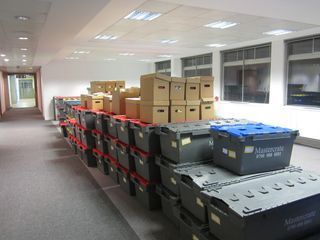
Anyway that is the state of the office as of last Friday -- all being boxed up for a speedy weekend move. But meanwhile, yes, there is paper to get out. So here you have a team of valient literary journalists carrying on, while the office collapses around them.
 Here you have Ms Vaux, finding the strain is getting to her a bit.
Here you have Ms Vaux, finding the strain is getting to her a bit.
And here on the right is Jim Campbell, who seems to have escaped the survivors' pic.
And Adrian Tahourdin another escapee, but here he is, below left clearing his shelves (a bit blurry, sorry A).
 Then there is Rupert, smiling through.
Then there is Rupert, smiling through.
And the men working away at their "island"
Not to forget Maureen in her office (looks like the heating's been turned off already). So everyone, when you pick up you TLS as usual, just think under what conditions it's been produced. The literary journalistic equivalent of blitz spirit.
November 30, 2012
Were there Christians at Pompeii? The word-square evidence.
I have had a large number of emails in the last week, asking me if there really were Christians at Pompeii. The prompt for this was Waldemar Januszczak's BBC4 programme on the Dark Ages -- which had some amazing stuff, but also claimed that there were Christians at Pompeii. The evidence for this was the scratched word square (like the one above).
It reads: "Sator/Arepo/Tenet/Opera /Rotas/" You'll see its clever "palindromic-ness" . It means (literally translated) "Arepo the sower holds the wheels at his work". But, as is often pointed out, the letters can be re-arranged into two "pater noster"s in the sign of a cross with a couple of "a"s and "o"s left over -- as in (converting to Greek) "alpha and omega". So it looks as if there could be a Christian significance: "our father" plus alpha and omega.
This "game" is found in all kind of places in the Roman world (including Cirencester) and it is often thought to be evidence of Christianity. One has been discovered in the palaestra in Pompeii ... but is it really evidence of Christianity as W J insisted in his programme? Probably not.
The whole issue has been discussed since the 1880s, but the likelihood is that this word square is originally a Jewish symbol. Certainly there are big problems in assuming that this is a Christian message pre AD 79. You can find the most sensible discussion here. But these are the basic arguments.
The idea of finding Christians in Pompeii or Herculaneum has been a holy grail for centuries. But nothing has ever proved their presence (the most famous sign of the cross appears to have been the traces left by a set of shelves).One suggestion has been that this word square with its apparently Christian message was the scratching of people who dug down into Pompeii after the eruption. That's not impossible. But much more likely is that it wasnt a Christian message at all.
The point is that -- even assuming the puzzle is to be resolved as a Pater Noster cross plus alpha and omega -- the cross does not appear (so far as we know) to have been a distinctively Christian symbol until much later than 79, and alpha and omega don't appear as Christian inscriptions until the third century AD (and that symbolism depends on apocalyptic literature later than 79). Besides, given the eastern origins of Christianity, you would expect any early Christian slogans to have been in Greek not Latin.
It is much more likely that we are dealing with a Latin-speaking Jewish slogan here, and there is plenty of evidence for Jews in the Vesuvian towns (including a kosher version of garum, the Roman staple of rotten fish sauce). "Alpha" and "omega" are well known in Jewish literature, and "our father" is perfectly compatible with a Jewish cultural background (and are found as that in Jewish prayers).
I'm afraid that ideas of Christians at Pompeii are a bit of a fantasy. Sorry.
November 28, 2012
Cambridge's royal visit and my day
I have been teaching all day, while our Duke and Duchess have been paying a royal visit. So I wave the flag in my head (well, errr ??), while actually being busy on all kinds of other things.
It's the last week of term and let me inflict on you what my uni day has been, before we get on to our royal family. This is partly for those very few readers of this blog who might be under the impression that we academics don't work hard enough. . .
Today I had a late-ish formal start (though I'd been up reading stuff hours before) -- with a student at 10.00 to talk about her dissertation.Then there was a lecture at 11.00 (with my much beloved 1A history group -- yes, YOU, Part 1A guys and gals), then another student dissertation to talk about at 12.00. At 1.00 I had a meeting with people from the Development Office about an event we are doing next week. That was before I met my MPhil group at 2.30, for our penultimate session of the term (OK it was in the pub, and a bit alcohol and fruit-juice assisted, but we reviewed the term, talked about last week's seminar, what the students would be doing for their next essays -- we're meeting again at my house on Sunday for follow-up and mince pies). Then I went directly back to college to see the Newnham Part 1B students in pairs, for an hour each until 6.30. Essays on Greek religion.. more specifically sacrifice and how best to understand it.
Meanwhile . . .
. . . the HRHs had been in town. From what I hear, I would have liked William's little joke that staying a couple of nights at Trinity was as close as Harry would get to being at uni. And it raised a laugh. But why did the visit have to disrupt the life of the city so much?
The old Duke of Edinburgh used to helicopter in with not much more than a couple of extra bobbies on view. A friend of mine tried to bike through the Market Square at 8.00 am this morning... oh no love, the officer said, you cant bike through here, because of the royal visit.
Does that add up? What kind of weapons are you supposed to carry on your bike when ridden that you can't take when walking it?
November 24, 2012
Reconstructing the classics: from Pompeii to Athens.
I just did my third talk in A Point of View (one more to go, to write this weekend...) about the plaster casts of Pompeii, which was sparked off by the conference at the Getty I went to last weekend and the show at the Getty Museum. (You can read it here or listen here.)
As I've said before it is weird how long it takes to write a 10 minute radio talk (somehow, it's in your head all week). But, on the other hand, it always turns out that you dont have time to get in all you wanted to. (Well, of cource not, it's only 10 minutes.)
This week I was particularly sad not to be able to name check the extraordinary broadcast by Matthew Halton for CBC, which is actually a live commentary on the Battle of Pompeii in 1943 (pretty early on in the battle, as he says at one point that the ancient city is still relatively unscathed... in the end it took the hit of more than 160 allied bombs). For me this is the second most moving account of the destruction of Pompeii, after that of Pliny the Younger. You can listen here (really worth it!).
But the first version of the talk had included all kind of examples outside Pompeii. They made it far too long and didn't in the end fit very well anyway (you HAVE to keep focussed in 10 minutes), but they were relevant in their way.
It would have been nice to show in more detail that the reconstruction and rebuilding of Pompeii was more typical of all the so-called "preserved" monuments that we treasure from the distant past. Because the truth is that nothing miraculously survives from thousands of years ago without a bit of help (whether active help in terms of rebuilding, or more passive help in terms of being re-used or built into a later structure -- like the Arch of Titus in the Roman Forum, or the Pantheon for that matter).
One obvious example is the Parthenon in Athens, which has been rebuilt as a semi-ruin twice over the last 100 years (in fact more years have now been spent on the rebuild than on the first build in the fifth century BCE). But an even more glaring case is the Temple of Athena Nike in Athens, the little jewel of a temple that overlooks you as you climb up to the Acropolis.
"After three separate restorations the small Temple of Athena Nike/Apteros still stands on the Acropolis" says the Wiki entry. Well, err, yes. But its bits were actually found in the 1830s, totally dismantled and built into the Turkish bastion that surrounded the hill. The three restorations are three different versions of the 3D jigsaw puzzles that aimed to put it all back together again.
Still stands? Depends a bit on what you mean by "still". "Again" might be more accurate.
Mary Beard's Blog
- Mary Beard's profile
- 4134 followers



